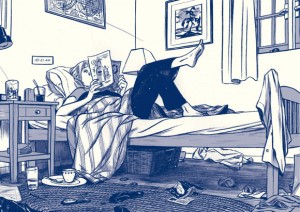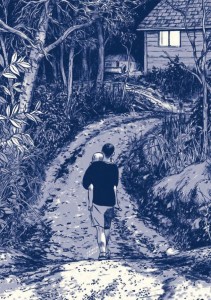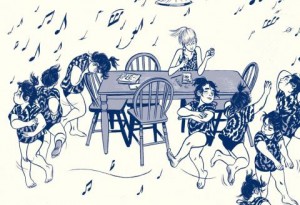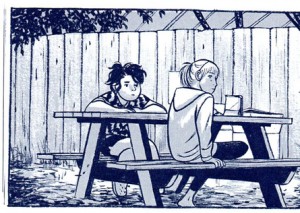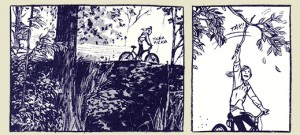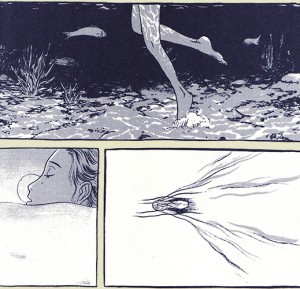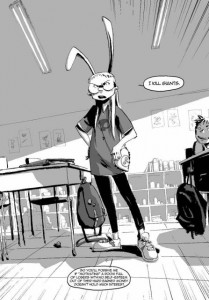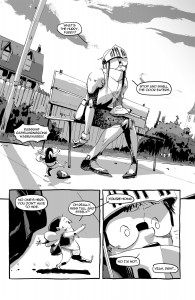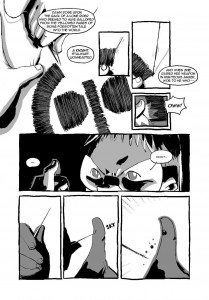 |
| Images (c) Marvel Entertainment. |
Wilson, Alphona, and the Marvel team have created a
modern twist to
Ms. Marvel offering fun and diversity for
tween readers and beyond.
Ms. Marvel
is a finalist for the first Dwayne McDuffie Award for Diversity (nominees range
from independent to mainstream comic books), and one of YALSA’s Top Ten 2015
Great Graphic Novels for Teens. It is also one of YALSA’s 2015 Quick Picks for
Reluctant Young Adult Readers.
OVERVIEW
Ms. Mavels: No Normal
encompasses the first five issues of Marvel’s new reboot. It features a Muslim Pakistani
American (polymorph) super heroine who struggles with identity issues whether
she’s in or out of her costume. Kamala’s
polymorph superpowers are a wonderful metaphor reflecting her inner struggles
as she stretches, bends, and recoils from the pressures all around her.
Throughout this volume, Kamala Khan not only struggles with her identity, but with
the different-ways and expectations of her religion, with the pressures and
expectations from her strict (but nurturing) parents, and with her power as
well. Throughout all these conflicts, Kamala must also be careful as a
polymorph to not be all things to
all people, which in the long run, might be very dangerous.
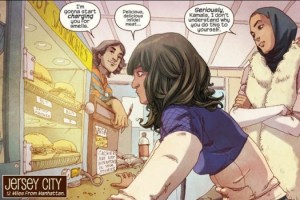 |
| Images (c) Marvel Entertainment. |
The readers, while passive observers, can’t help but be
drawn into this story. Despite Kamala’s
diverse cultural background, or maybe because of it, she’s in many ways, also a
wonderfully typical teenager, wrestling with being a Jersey City girl who
happens to come from a modern religious family. Like most teens she’s just
trying to figure out how to fit in. Throughout this book, the text provides
wonderful insights into Kamala’s thoughts and character, while moving quickly
along. The art is equally engaging and
inviting. Alphona’s somewhat comic figures balance Kamala’s real-life conflicts
with Wilson’s wit, drawing us deeper and deeper into the story.
Note that while this is a reboot, readers do not necessarily
need to know the original story. It may
help, though, as there are some gaps in the beginning of the story. That said, Ms. Marvel is engaging for all readers
(tweens and up) and is full of wonderful witticisms and humor while subtly
introducing diversity in a previously told but equally engaging story.
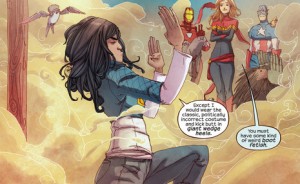 |
| Images (c) Marvel Entertainment. |
Ms. Marvel is
about:
·
The typical American girl teenage experience;
·
The struggles and pressures of assimilation and fitting
in while retaining family background, family history, and family religion;
·
The stresses of being an individual trying to
fit into various cultural “boxes” or communities, which may or may not conflict
with each other;
·
The ability to balance gifts and pressures in
the world around her;
·
The fact that while a Muslim and a polymorph,
what shapes and drives Kamala are her personality, her parents’ teachings, her
inner strengths and her values – not her labels.
SUMMARY/REVIEW
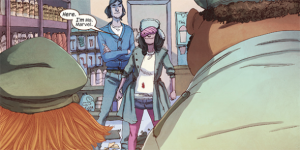 |
| Images (c) Marvel Entertainment. |
In Ms. Marvel: No Normal, Kamala, a sixteen
year old Muslim Pakistani-American, has a “sad nerd obsession with the
Avengers” and tries to bridge her Muslim world and friends with the Jersey City
kids she goes to school with. The book opens with Kamala and her friend Nakia
in the Circle Q convenience store talking with Bruno (Kamala’s “second best
friend”). Zoe and her boyfriend, Josh walk in and Zoe, all peaches and cream,
condescendingly patronizes Kamala and her friends while inviting them to a
waterfront party. While Nakia has no interest
in attending (because they’ll be drinking alcohol which is against her
religion), Kamala wants to go. Despite
the fact that Kamala’s parents refuse to let her go, she sneaks out and goes
anyway. While she sees and approaches
Bruno, Zoe comes over to her, openly insults her, and Kamala runs away after
they trick her into drinking alcohol. As
she runs away, a mist envelops Jersey City, and Kamala meets the Avengers.
Not
understanding where she is or what she’s seeing, Captain America tells her, "You are seeing
what you need to see. You stand at a crossroads. You thought that if
you disobeyed your parents – your culture, your religion – your classmates
would accept you. What happened instead?” Kamala explains that they laughed at
her and mocked her family and “brown people” but that she was there because she
grew up American, from Jersey City and “I don’t know what I’m supposed to do. I
don’t know who I’m supposed to be.” When
Captain Marvel - Carol Danvers asks her who she wants to be, Kamala answers, “I
want to be you.” And just like that, she becomes a polymorph, although Captain
Marvel warns her, “It is not going to turn out the way you think.”
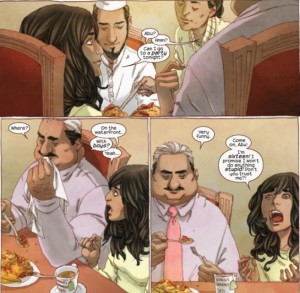 |
| Images (c) Marvel Entertainment. |
In Ms. Marvel: No Normal, Kamala learns
that becoming blonde and Caucasian doesn't make her happy or glamorous or even
popular. She eventually realizes however, that changing shape doesn't mean she
can erase who she is. It doesn’t protect her from others insulting her values,
her family’s values or her religion. It also doesn’t protect her from the wrath
of her parents or from Sheikh Abdullah who runs their mosque and its youth lectures
she has to attend. Kamala even admits that,
“Being
someone else isn't liberating. It's exhausting. I always thought that if I had
amazing hair, if I could pull off great boots, if I could fly—that would make
me happy. But the hair gets in my face, the boots pinch … and the leotard
is giving me an epic wedgie.”
Kamala
also finds that her father’s teachings of the Quran give her the vision and
strength to use her powers. Just before deciding to rescue Zoe, she remembers a
passage from the Quran: "Whoever saves one person, it is as if he has
saved all of mankind." She soon learns that while she may look like Captain
Marvel on the outside, that's just a costume. What's inside is Kamala, and part
of who Kamala is - her family, her religion, her friends, and her ethnicity-
are what ultimately guide her and help her realize who she is and how she fits
in.
While
Wilson and Alphona
have created a superhero comic in the classic Marvel mode, they offer a more
progressive perspective in the characters, text and artwork. Alphona provides a
wonderful balance of gravitas and whimsy in his art, keeping the tone light and
fun with his cartoonish-y exaggerated character expressions and flourishes.
Balancing this quirkiness is Wilson’s insightful text filled with imagery of
its own. Alphona’s cartoonish characters, fashion details, and use of color are
engaging and add a delightful depth complementing Wilson’s highly expressive,
real-life text. All this enables readers to embrace the diversity of their
characters while adding a breath of fresh air to this rebooted story.
 |
| Images (c) Marvel Entertainment. |
Whether
used in classrooms or just read for fun, there is great depth of character and
this book provides a wonderful look at the balancing of family, religion, and
pop culture that all tweens and teens deal with.
Suggested Prose,
Graphic Novel and Poetry Pairings
·
D’Aulaires
Book of Greek Myths by Ingri and Edgar D’Aulaire: an introduction to the
gods and goddesses of ancient Greece. Note that George O’Connor (First Second
Books) is also putting out an exceptional collection of graphic novels
accurately and creatively accounting the stories of the Greek gods. When
reading these Greek Myths, discuss how Kamala’s story does and does not
parallel these myths.
·
The
Absolutely True Story of a Part Time Indian by Sherman Alexie: About a bright
motivated young Native American who must decide about commuting to a better
all-white school off the reservation and face ridicule (by white kids he must
befriend and from his local friends he leaves behind), or remain with his
friends who are heading know where fast. Compare and contrast how the
characters from different cultures strive to fit in.
·
American
Born Chinese by Gene Luen Yang: about a Chinese boy who struggles to fit in
with his American classmates. Compare
and contrast how Jin Wang and Kamala are similar/different and how they
struggle to be American.
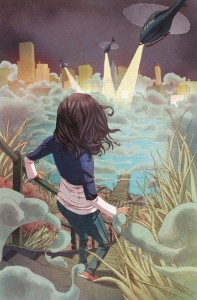 |
| Images (c) Marvel Entertainment. |
·
Captain
Marvel; Young Avengers; and Captain
Marvel: Earth’s Mightiest Hero – Marvel comic series. Compare and contrast these Avenger/Captain
Marvel series.
ADDITIONAL RESOURCES:
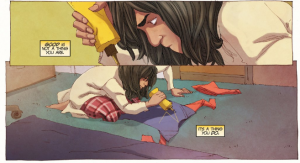 |
| Images (c) Marvel Entertainment. |
As always, thanks for your visit.
Please leave your reactions in the comments below.


